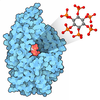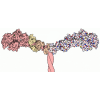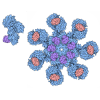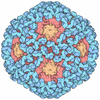+ Open data
Open data
- Basic information
Basic information
| Entry | Database: PDB / ID: 8xvg | ||||||
|---|---|---|---|---|---|---|---|
| Title | Structure of human NuA4/TIP60 complex | ||||||
 Components Components |
| ||||||
 Keywords Keywords | TRANSCRIPTION / Remodeler / Histone Acetyltransferase Complex / NuA4 / TIP60 | ||||||
| Function / homology |  Function and homology information Function and homology informationpiccolo histone acetyltransferase complex / promoter-enhancer loop anchoring activity / telomerase RNA localization to Cajal body / regulation of DNA strand elongation / positive regulation of telomere maintenance in response to DNA damage / sperm DNA condensation / histone chaperone activity / establishment of protein localization to chromatin / transcription factor TFTC complex / R2TP complex ...piccolo histone acetyltransferase complex / promoter-enhancer loop anchoring activity / telomerase RNA localization to Cajal body / regulation of DNA strand elongation / positive regulation of telomere maintenance in response to DNA damage / sperm DNA condensation / histone chaperone activity / establishment of protein localization to chromatin / transcription factor TFTC complex / R2TP complex / dynein axonemal particle / neural retina development / npBAF complex / brahma complex / Swr1 complex / RPAP3/R2TP/prefoldin-like complex / GBAF complex / regulation of G0 to G1 transition / protein antigen binding / Ino80 complex / chromatin-protein adaptor activity / blastocyst formation / RSC-type complex / regulation of double-strand break repair / regulation of nucleotide-excision repair / box C/D snoRNP assembly / protein folding chaperone complex / SAGA complex / SWI/SNF complex / regulation of mitotic metaphase/anaphase transition / positive regulation of T cell differentiation / Formation of Senescence-Associated Heterochromatin Foci (SAHF) / positive regulation of double-strand break repair / spinal cord development / DNA repair-dependent chromatin remodeling / negative regulation of gene expression, epigenetic / regulation of chromosome organization / NuA4 histone acetyltransferase complex / Transcriptional Regulation by E2F6 / RUNX1 interacts with co-factors whose precise effect on RUNX1 targets is not known / regulation of RNA splicing / positive regulation of stem cell population maintenance / Regulation of MITF-M-dependent genes involved in pigmentation / TFIID-class transcription factor complex binding / regulation of DNA replication / regulation of G1/S transition of mitotic cell cycle / MLL1 complex / regulation of embryonic development / Telomere Extension By Telomerase / somatic stem cell population maintenance / negative regulation of cell differentiation / spermatid development / enzyme-substrate adaptor activity / positive regulation of myoblast differentiation / RNA polymerase II core promoter sequence-specific DNA binding / regulation of DNA repair / positive regulation of double-strand break repair via homologous recombination / Deposition of new CENPA-containing nucleosomes at the centromere / telomere maintenance / DNA helicase activity / transcription initiation-coupled chromatin remodeling / TBP-class protein binding / positive regulation of DNA repair / replication fork / transcription coregulator activity / positive regulation of cell differentiation / Regulation of endogenous retroelements by Piwi-interacting RNAs (piRNAs) / cellular response to estradiol stimulus / negative regulation of canonical Wnt signaling pathway / euchromatin / Formation of the beta-catenin:TCF transactivating complex / helicase activity / double-strand break repair via homologous recombination / DNA Damage Recognition in GG-NER / ADP binding / beta-catenin binding / chromatin DNA binding / kinetochore / DNA Damage/Telomere Stress Induced Senescence / positive regulation of protein import into nucleus / Hydrolases; Acting on acid anhydrides; Acting on acid anhydrides to facilitate cellular and subcellular movement / RMTs methylate histone arginines / nuclear matrix / cellular response to UV / UCH proteinases / transcription corepressor activity / unfolded protein binding / positive regulation of canonical Wnt signaling pathway / protein folding / nervous system development / nucleosome / site of double-strand break / HATs acetylate histones / chromatin organization / ATPase binding / response to ethanol / spermatogenesis / nuclear membrane / regulation of apoptotic process / DNA recombination Similarity search - Function | ||||||
| Biological species |  Homo sapiens (human) Homo sapiens (human) | ||||||
| Method | ELECTRON MICROSCOPY / single particle reconstruction / cryo EM / Resolution: 9.4 Å | ||||||
 Authors Authors | Chen, K. / Wang, L. / Yu, Z. / Yu, J. / Ren, Y. / Wang, Q. / Xu, Y. | ||||||
| Funding support |  China, 1items China, 1items
| ||||||
 Citation Citation |  Journal: Nat Commun / Year: 2024 Journal: Nat Commun / Year: 2024Title: Structure of the human TIP60 complex. Authors: Ke Chen / Li Wang / Zishuo Yu / Jiali Yu / Yulei Ren / Qianmin Wang / Yanhui Xu /  Abstract: Mammalian TIP60 is a multi-functional enzyme with histone acetylation and histone dimer exchange activities. It plays roles in diverse cellular processes including transcription, DNA repair, cell ...Mammalian TIP60 is a multi-functional enzyme with histone acetylation and histone dimer exchange activities. It plays roles in diverse cellular processes including transcription, DNA repair, cell cycle control, and embryonic development. Here we report the cryo-electron microscopy structures of the human TIP60 complex with the core subcomplex and TRRAP module refined to 3.2-Å resolution. The structures show that EP400 acts as a backbone integrating the motor module, the ARP module, and the TRRAP module. The RUVBL1-RUVBL2 hexamer serves as a rigid core for the assembly of EP400 ATPase and YL1 in the motor module. In the ARP module, an ACTL6A-ACTB heterodimer and an extra ACTL6A make hydrophobic contacts with EP400 HSA helix, buttressed by network interactions among DMAP1, EPC1, and EP400. The ARP module stably associates with the motor module but is flexibly tethered to the TRRAP module, exhibiting a unique feature of human TIP60. The architecture of the nucleosome-bound human TIP60 reveals an unengaged nucleosome that is located between the core subcomplex and the TRRAP module. Our work illustrates the molecular architecture of human TIP60 and provides architectural insights into how this complex is bound by the nucleosome. | ||||||
| History |
|
- Structure visualization
Structure visualization
| Structure viewer | Molecule:  Molmil Molmil Jmol/JSmol Jmol/JSmol |
|---|
- Downloads & links
Downloads & links
- Download
Download
| PDBx/mmCIF format |  8xvg.cif.gz 8xvg.cif.gz | 2.1 MB | Display |  PDBx/mmCIF format PDBx/mmCIF format |
|---|---|---|---|---|
| PDB format |  pdb8xvg.ent.gz pdb8xvg.ent.gz | Display |  PDB format PDB format | |
| PDBx/mmJSON format |  8xvg.json.gz 8xvg.json.gz | Tree view |  PDBx/mmJSON format PDBx/mmJSON format | |
| Others |  Other downloads Other downloads |
-Validation report
| Summary document |  8xvg_validation.pdf.gz 8xvg_validation.pdf.gz | 1.8 MB | Display |  wwPDB validaton report wwPDB validaton report |
|---|---|---|---|---|
| Full document |  8xvg_full_validation.pdf.gz 8xvg_full_validation.pdf.gz | 1.9 MB | Display | |
| Data in XML |  8xvg_validation.xml.gz 8xvg_validation.xml.gz | 209 KB | Display | |
| Data in CIF |  8xvg_validation.cif.gz 8xvg_validation.cif.gz | 321.8 KB | Display | |
| Arichive directory |  https://data.pdbj.org/pub/pdb/validation_reports/xv/8xvg https://data.pdbj.org/pub/pdb/validation_reports/xv/8xvg ftp://data.pdbj.org/pub/pdb/validation_reports/xv/8xvg ftp://data.pdbj.org/pub/pdb/validation_reports/xv/8xvg | HTTPS FTP |
-Related structure data
| Related structure data |  38703MC 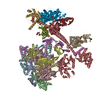 8xvtC 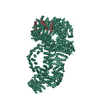 8xvvC M: map data used to model this data C: citing same article ( |
|---|---|
| Similar structure data | Similarity search - Function & homology  F&H Search F&H Search |
- Links
Links
- Assembly
Assembly
| Deposited unit | 
|
|---|---|
| 1 |
|
- Components
Components
-Isoform 2 of ... , 3 types, 3 molecules LHM
| #1: Protein | Mass: 434949.906 Da / Num. of mol.: 1 Source method: isolated from a genetically manipulated source Source: (gene. exp.)  Homo sapiens (human) / Gene: TRRAP, PAF400 / Cell line (production host): Expi293F / Production host: Homo sapiens (human) / Gene: TRRAP, PAF400 / Cell line (production host): Expi293F / Production host:  Homo sapiens (human) / References: UniProt: Q9Y4A5 Homo sapiens (human) / References: UniProt: Q9Y4A5 |
|---|---|
| #5: Protein | Mass: 340198.062 Da / Num. of mol.: 1 Source method: isolated from a genetically manipulated source Source: (gene. exp.)  Homo sapiens (human) / Gene: EP400, CAGH32, KIAA1498, KIAA1818, TNRC12 / Cell line (production host): Expi293F / Production host: Homo sapiens (human) / Gene: EP400, CAGH32, KIAA1498, KIAA1818, TNRC12 / Cell line (production host): Expi293F / Production host:  Homo sapiens (human) Homo sapiens (human)References: UniProt: Q96L91, Hydrolases; Acting on acid anhydrides; Acting on acid anhydrides to facilitate cellular and subcellular movement |
| #8: Protein | Mass: 90988.273 Da / Num. of mol.: 1 Source method: isolated from a genetically manipulated source Source: (gene. exp.)  Homo sapiens (human) / Gene: EPC1 / Cell line (production host): Expi293F / Production host: Homo sapiens (human) / Gene: EPC1 / Cell line (production host): Expi293F / Production host:  Homo sapiens (human) / References: UniProt: Q9H2F5 Homo sapiens (human) / References: UniProt: Q9H2F5 |
-Protein , 6 types, 11 molecules ACEBDFGIJKN
| #2: Protein | Mass: 50296.914 Da / Num. of mol.: 3 Source method: isolated from a genetically manipulated source Source: (gene. exp.)  Homo sapiens (human) / Gene: RUVBL1, INO80H, NMP238, TIP49, TIP49A / Cell line (production host): Expi293F / Production host: Homo sapiens (human) / Gene: RUVBL1, INO80H, NMP238, TIP49, TIP49A / Cell line (production host): Expi293F / Production host:  Homo sapiens (human) / References: UniProt: Q9Y265, DNA helicase Homo sapiens (human) / References: UniProt: Q9Y265, DNA helicase#3: Protein | Mass: 51222.465 Da / Num. of mol.: 3 Source method: isolated from a genetically manipulated source Source: (gene. exp.)  Homo sapiens (human) / Gene: RUVBL2, INO80J, TIP48, TIP49B, CGI-46 / Cell line (production host): Expi293F / Production host: Homo sapiens (human) / Gene: RUVBL2, INO80J, TIP48, TIP49B, CGI-46 / Cell line (production host): Expi293F / Production host:  Homo sapiens (human) / References: UniProt: Q9Y230, DNA helicase Homo sapiens (human) / References: UniProt: Q9Y230, DNA helicase#4: Protein | | Mass: 53090.699 Da / Num. of mol.: 1 Source method: isolated from a genetically manipulated source Source: (gene. exp.)  Homo sapiens (human) / Gene: DMAP1, KIAA1425 / Cell line (production host): Expi293F / Production host: Homo sapiens (human) / Gene: DMAP1, KIAA1425 / Cell line (production host): Expi293F / Production host:  Homo sapiens (human) / References: UniProt: Q9NPF5 Homo sapiens (human) / References: UniProt: Q9NPF5#6: Protein | Mass: 47509.812 Da / Num. of mol.: 2 Source method: isolated from a genetically manipulated source Source: (gene. exp.)  Homo sapiens (human) / Gene: ACTL6A / Cell line (production host): Expi293F / Production host: Homo sapiens (human) / Gene: ACTL6A / Cell line (production host): Expi293F / Production host:  Homo sapiens (human) / References: UniProt: O96019 Homo sapiens (human) / References: UniProt: O96019#7: Protein | | Mass: 41782.660 Da / Num. of mol.: 1 Source method: isolated from a genetically manipulated source Source: (gene. exp.)  Homo sapiens (human) / Gene: Actb / Cell line (production host): Expi293F / Production host: Homo sapiens (human) / Gene: Actb / Cell line (production host): Expi293F / Production host:  Homo sapiens (human) / References: UniProt: A0A7K5XZZ2 Homo sapiens (human) / References: UniProt: A0A7K5XZZ2#9: Protein | | Mass: 40658.363 Da / Num. of mol.: 1 Source method: isolated from a genetically manipulated source Source: (gene. exp.)  Homo sapiens (human) / Gene: VPS72, TCFL1, YL1 / Cell line (production host): Expi293F / Production host: Homo sapiens (human) / Gene: VPS72, TCFL1, YL1 / Cell line (production host): Expi293F / Production host:  Homo sapiens (human) / References: UniProt: Q15906 Homo sapiens (human) / References: UniProt: Q15906 |
|---|
-Non-polymers , 2 types, 10 molecules 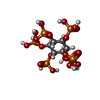
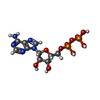

| #10: Chemical | ChemComp-IHP / |
|---|---|
| #11: Chemical | ChemComp-ADP / |
-Details
| Has ligand of interest | Y |
|---|
-Experimental details
-Experiment
| Experiment | Method: ELECTRON MICROSCOPY |
|---|---|
| EM experiment | Aggregation state: PARTICLE / 3D reconstruction method: single particle reconstruction |
- Sample preparation
Sample preparation
| Component | Name: Structure of human NuA4/TIP60 complex / Type: COMPLEX / Entity ID: #2-#7, #1, #8-#9 / Source: RECOMBINANT |
|---|---|
| Source (natural) | Organism:  Homo sapiens (human) Homo sapiens (human) |
| Source (recombinant) | Organism:  Homo sapiens (human) Homo sapiens (human) |
| Buffer solution | pH: 7.4 |
| Specimen | Embedding applied: NO / Shadowing applied: NO / Staining applied: NO / Vitrification applied: YES |
| Vitrification | Cryogen name: ETHANE |
- Electron microscopy imaging
Electron microscopy imaging
| Experimental equipment |  Model: Titan Krios / Image courtesy: FEI Company |
|---|---|
| Microscopy | Model: FEI TITAN KRIOS |
| Electron gun | Electron source:  FIELD EMISSION GUN / Accelerating voltage: 300 kV / Illumination mode: FLOOD BEAM FIELD EMISSION GUN / Accelerating voltage: 300 kV / Illumination mode: FLOOD BEAM |
| Electron lens | Mode: BRIGHT FIELD / Nominal defocus max: 2800 nm / Nominal defocus min: 1500 nm |
| Image recording | Electron dose: 50 e/Å2 / Film or detector model: GATAN K3 (6k x 4k) |
- Processing
Processing
| CTF correction | Type: PHASE FLIPPING AND AMPLITUDE CORRECTION |
|---|---|
| 3D reconstruction | Resolution: 9.4 Å / Resolution method: FSC 0.143 CUT-OFF / Num. of particles: 20275 / Symmetry type: POINT |
 Movie
Movie Controller
Controller






 PDBj
PDBj

